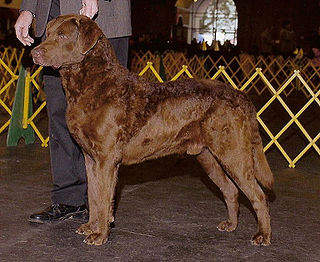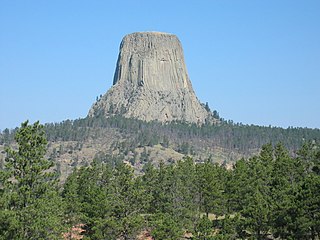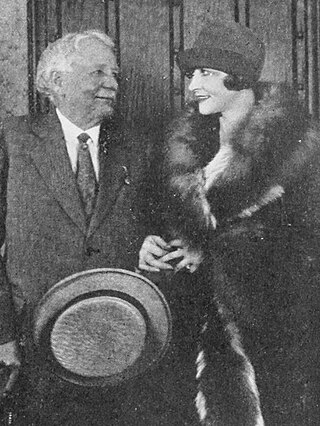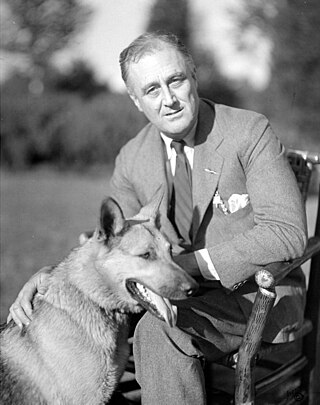
Theodore Roosevelt Jr., often referred to as Teddy or T. R., was an American politician, soldier, conservationist, historian, naturalist, explorer and writer who served as the 26th president of the United States from 1901 to 1909. He previously was involved in New York politics, including serving as the state's 33rd governor for two years. He was the vice president under President William McKinley for six months in 1901, assuming the presidency after McKinley's assassination. As president, Roosevelt emerged as a leader of the Republican Party and became a driving force for anti-trust and Progressive policies.

The Chesapeake Bay Retriever is a large breed of dog belonging to the retriever, gundog, and sporting breed groups. The breed was developed in the United States Chesapeake Bay area during the 19th century. Historically used by local market hunters to retrieve waterfowl, pull fishing nets, and rescue fishermen, it is today primarily a family pet and hunting companion, known for a bright and happy disposition; courage; willingness to work; alertness; intelligence; love of water; and hunting capabilities. The Chesapeake is a medium- to large-sized dog similar in appearance to the Labrador Retriever, but with a wavy coat.

Devils Tower is a butte, possibly laccolithic, composed of igneous rock in the Bear Lodge Ranger District of the Black Hills, near Hulett and Sundance in Crook County, northeastern Wyoming, above the Belle Fourche River. It rises 1,267 feet (386 m) above the Belle Fourche River, standing 867 feet (264 m) from summit to base. The summit is 5,112 feet (1,558 m) above sea level.

Most United States presidents have kept pets while in office, or pets have been part of their families. Only James K. Polk, Andrew Johnson, and Donald Trump did not have any presidential pets while in office. However, Johnson did take care of some mice he found in his bedroom.

Theodore Roosevelt V, also called Theodore IV, is an American investment banker and managing director at Barclays Investment Bank. He is a member of the Council on Foreign Relations, the Economic Club of New York, and the Foreign Policy Association, and serves on the Advisory Council of Represent.Us, a nonpartisan anti-corruption organization. Roosevelt is also a prominent conservationist. His name suffix varies since his great-grandfather, President Theodore Roosevelt, was a son of Theodore Roosevelt Sr., though the same-named son did not commonly use a "Jr." name suffix.

The Teddy Roosevelt Terrier is a small to medium-sized American hunting terrier. It is lower-set, with shorter legs, and is more muscular with heavier bone density than the related American Rat Terrier. Much diversity exists in the history of the Teddy Roosevelt Terrier breed, and it shares a common early history with the American Rat Terrier, Fox Paulistinha, and Tenterfield Terrier. The Rat Terrier's background is said to stem from the terriers or other dogs that were brought over by early English and other working-class immigrants. Since the breed was a farm, hunting, and utility dog, little to no planned breeding was used other than breeding dogs with agreeable traits to each other to produce the desired work ethic in the dog. The Feist (dog), Bull Terrier, Smooth Fox Terrier, Manchester Terrier, Whippet, Italian Greyhound, the now extinct English White Terrier, Turnspit Dog, and Wry-legged Terrier all share in the Teddy Roosevelt Terrier's ancestry. These early ratting terriers were then most likely bred to the Beagle or Beagle crossbred dogs and other dogs. Maximizing the influences from these various breeds provides the modern Teddy Roosevelt Terrier with a keen sense of awareness and prey drive, an acute sense of smell, and a very high intellect. Although they tend to be aloof with strangers, they are devoted companion dogs with a strong desire to please and be near their owners at all times.

The Bull Terrier is a breed of dog in the terrier family. There is also a miniature version of this breed which is officially known as the Miniature Bull Terrier. This breed originates in 19th century England. Originally bred for vermin control and bloodsports, this breed can be independent and stubborn.

Albert Payson Terhune was an American writer, dog breeder, and journalist. He was popular for his novels relating the adventures of his beloved collies and as a breeder of collies at his Sunnybank Kennels, the lines of which still exist in today's Rough Collies.

Theodore Roosevelt Sr. was an American businessman and philanthropist from the Roosevelt family. Roosevelt was also the father of President Theodore Roosevelt and the paternal grandfather of First Lady Eleanor Roosevelt. He served as a member of the plate-glass importing business Roosevelt & Son.

A feist is a small hunting dog. This group descended from the terriers brought over to the United States by British miners and other immigrants. These terriers probably included crosses between the Smooth Fox Terrier, the Manchester Terrier, and the now-extinct English White Terrier. These dogs were used as ratters, and gambling on their prowess in killing rats was a favorite hobby of their owners. Some of these dogs have been crossed with Greyhounds, Whippets or Italian Greyhounds, and Beagles or other hounds — extending the family to include a larger variety of purpose than the original ratter, or Rat Terrier.

The Bisbee Deportation was the illegal kidnapping and deportation of about 1,300 striking mine workers, their supporters, and citizen bystanders by 2,000 members of a deputized posse, who arrested them beginning on July 12, 1917, in Bisbee, Arizona. The action was orchestrated by Phelps Dodge, the major mining company in the area, which provided lists of workers and others who were to be arrested to the Cochise County sheriff, Harry C. Wheeler. Those arrested were taken to a local baseball park before being loaded onto cattle cars and deported 200 miles (320 km) to Tres Hermanas in New Mexico. The 16-hour journey was through desert without food and with little water. Once unloaded, the deportees, most without money or transportation, were warned against returning to Bisbee. The US government soon brought in members of the US Army to assist with relocating the deportees to Columbus, New Mexico.

Harry Cornwall Wheeler was an Arizona lawman who was the third captain of the Arizona Rangers, as well as the sheriff of Cochise County, serving from 1912 into 1918. He is known as the lead figure in the illegal mass kidnapping and deportation of some 1200 miners and family members, many of them immigrants, from Bisbee, Arizona to New Mexico in 1917. Beginning on July 12, 1917, he took total control of the town of Bisbee, controlling access and running kangaroo courts that deported numerous people.

Ethel Geraldine Rockefeller Dodge was the youngest child of William Avery Rockefeller Jr. and Almira Geraldine (Goodsell) Rockefeller. Giralda Farms was the name given to the New Jersey country estate where the family lived. She was a great patron of the arts and parts of her collection became the object of a lawsuit following her death.

Henry Irving Dodge was an American writer. He was best known for creating the character "Skinner" which appeared in Skinner's Dress Suit and a number of additional stories in the 1910s.

The Yellow Dog is a 1918 American silent drama film directed by Colin Campbell and starring Arthur Hoyt, Antrim Short, and Clara Horton.

Major is a German Shepherd owned by Joe Biden's family. Major, who was born in 2018, is the first shelter dog to live in the White House. Previously, President John F. Kennedy and his wife Jackie had owned two German Shepherds.

Major, a German Shepherd, was a presidential pet belonging to United States president Franklin D. Roosevelt.
Pete was a pet dog belonging to United States president Theodore Roosevelt. He was one of many presidential pets during Roosevelt's presidency. He was reported to be a bull terrier, though other reports have said he was a Boston bull terrier or bulldog.

















